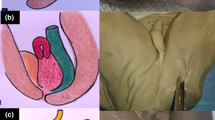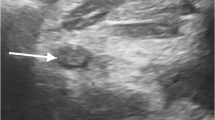Abstract
Introduction
Prenatal diagnosis of anorectal malformations currently occurs in 0–15.9% of screened cases. In cloacas, these numbers are unknown. We speculate that some images from prenatal ultrasound studies may suggest the diagnosis of cloaca, but are not recognized because of a lack of suspicion for this diagnosis.
Methods
A retrospective review of the medical records of 489 patients born with cloaca was performed; 95 of them had prenatal ultrasound reports that represent the material analyzed for this study. A literature review was performed, finding 31 publications, with 68 cloaca patients detected by prenatal images. The abnormal findings of our patients were compared with those described in the literature to determine the most common abnormal prenatal images found in patients with cloaca.
Results
The 95 ultrasound reports found in our patients described 270 abnormalities, the most frequent were: abdominal/pelvic cystic/mass (39), hydronephrosis (36), oligohydramnios (23), distended bowel/bowel obstruction (19), ascites (15), 2 vessel cord (14), dilated bladder (14), dilated ureter (14), polyhydramnios (10), echogenic bowel (8), multicystic kidney (8), “ambiguous genitalia” (7), hydrops fetalis (7), hydrocolpos (4), absent kidney (3), abnormal spine (3), and anorectal atresia (3). In spite of these findings, the radiologists who interpreted the studies only suspected a cloaca in 6 cases (6%). The literature review showed 212 abnormalities in 68 demonstrated cloaca patients. The most frequent were: abdominal/pelvic cystic/mass (46), hydronephrosis (44), ascites (21), oligohydramnios (20), distended bowel (11), multicystic dysplastic kidney (7), ambiguous genitalia (6), non-visualization of the bladder (6), two-vessel cord (5), dilated bladder (5), intraabdominal calcification (4), polyhydramnios (4), enterolithiasis (4), hydrometrocolpos (3), and dilated ureter (3).
Conclusion
We conclude that it is possible to suspect the diagnosis of cloaca, prenatally, more frequently than what currently occurs, looking at the same images but with an increased index of suspicion for cystic abdominal masses and a combination of gastrointestinal and urological abnormalities.

Similar content being viewed by others
References
Stoll C, Lembik Y, Dott B et al (1996) Evaluation of prenatal diagnosis of congenital gastro-intestinal atresias. Eur J Epidemiol 12:611–616
Baronciani D, Scaglia C, Corchia C et al (1995) Ultrasonography in pregnancy and fetal abnormalities: screening or diagnostic tests? IPIMC 1986–1990 register data. Prenat Diagn 15:1101–1108
Brantberg A, Blaas HGK, Haugen SE et al (2006) Imperforate anus: a relatively common anomaly rarely diagnosed prenatally. Ultrasound Obstet Gynecol 28:904–910
Bischoff A, Levitt MA, Breech L et al (2010) Hydrocolpos in cloacal malformations. J Pediatr Surg 45:1241–1245
Achiron R, Frydman M, Lipitz S et al (2000) Urorectal septum malformation sequence: prenatal sonographic diagnosis in two sets of discordant twins. Ultrasound Obstet Gynecol 16:571–574
Shono T, Taguchi T, Suita S et al (2007) Prenatal ultrasonographic and magnetic resonance imaging findings of congenital cloacal anomalies associated with meconium peritonitis. J Pediatr Surg 42:681–684
Hamada T, Hirose R, Kosaka T et al (2008) Giant cystic meconium peritonitis associated with a cloacal anomaly: case report. J Pediatr Surg 43:E21–E23
Adams MC, Ludlow J, Brock JW et al (1998) Prenatal urinary ascites and persistent cloaca: risk factors for poor drainage of urine or meconium. J Urol 160:2179–2181
Dhombres F, Jouannic JM, Brodaty G et al (2007) Contribution of prenatal imaging to the anatomical assessment of fetal hydrocolpos. Ultrasound Obstet Gynecol 30:101–104
Meyer SR, Smith KM, Ravish IR et al (2009) Complex cloacal anomaly in discordant monozygotic twins. Urology 73:532–534
Mori M, Matsubara K, Abe E et al (2007) Prenatal diagnosis of persistent cloaca associated with VATER (vertebral defects, anal atresia, tracheo-esophageal fistula, and renal dysplasia). Tohoku J Exp Med 213:291–295
Hung Y-H, Tsai C-C, Ou C-Y et al (2008) Late prenatal diagnosis of hydrometrocolpos secondary to a cloacal anomaly by abdominal ultrasonography with complementary magnetic resonance imaging. Taiwan J Obstet Gynecol 47:79–83
Hayashi S, Sago H, Kashima K et al (2005) Prenatal diagnosis of fetal hydrometrocolpos secondary to a cloacal anomaly by magnetic resonance imaging. Ultrasound Obstet Gynecol 26:577–579
Baier SR, Tank ES, Watson PT et al (2001) Persistent cloaca: prenatal diagnosis of hydrometrocolpos. JDMS 17:220–224
Suzumori N, Obayashi S, Hattori Y et al (2009) Prenatal diagnosis of persistent cloaca. Congenital Anomalies 49:116–117
Warne S, Chitty LS, Wilcox DT (2002) Prenatal diagnosis of cloacal anomalies. BJU Int 89:78–81
Cilento BG Jr, Benacerraf BR, Mandell J (1994) Prenatal diagnosis of cloacal malformation. Urology 43:386–388
Cacciaguerra S, Lo Presti L, Di Leo L et al (1998) Prenatal diagnosis of cloacal anomaly. Scand J Urol Nephrol 32:77–80
Morikawa M, Yamada T, Cho K et al (2006) Prenatal diagnosis and therapy of persistent cloaca: a case report. Fetal Diagn Ther 21:342–347
Bang WJ, Lee HY, Han SW (2008) Clinical characteristics of children with persistent cloaca: a urological perspective. Korean J Urol 49:77–81
Zaccara A, Gatti C, Silveri M et al (1999) Persistent cloaca: are we ready for a correct prenatal diagnosis? Urology 54:367
Anderson S, Savader B, Barnes J et al (1988) Enterolithiasis with imperforate anus. Report of two cases with sonographic demonstration and occurrence in a female. Pediatr Radiol 18:130–133
Bruce Belin, Coterville JE, Langer JC (1995) How accurate is prenatal sonography for the diagnosis of imperforate anus and Hirschsprung’s disease? Pediatr Surg Int 10:30–32
Shalev E, Feldman E, Weiner E et al (1986) Prenatal sonographic appearance of persistent cloaca. Acta Obstet Gynecol Scand 65:517–518
Petrikovsky BM, Walzak MP Jr, D’Addario PF (1988) Fetal cloacal anomalies: prenatal sonographic findings and differential diagnosis. Obstet Gynecol 72:464–469
Cianciosi A, Mancini F, Busacchi P et al (2006) Increased amniotic fluid volume associated with cloacal and renal anomalies. J Ultrasound Med 25:1085–1090
Geipel A, Berg C, Germer U et al (2001) Diagnostic and therapeutic problems in a case of prenatally detected fetal hydrocolpos. Ultrasound Obstet Gynecol 18:169–172
Picone O, Laperelle J, Sonigo P et al (2007) Fetal magnetic resonance imaging in the antenatal diagnosis and management of hydrocolpos. Ultrasound Obstet Gynecol 30:105–109
Lande IM, Hamilton EF (1986) The antenatal sonographic visualization of cloacal dysgenesis. J Ultrasound Med 5:275–278
Odibo AO, Turner GW, Borgida AF et al (1997) Late prenatal ultrasound features of hydrometrocolpos secondary to cloacal anomaly: case reports and review of the literature. Ultrasound Obstet Gynecol 9:419–421
Ohno Y, Koyama N, Tsuda M et al (2000) Antenatal ultrasonographic appearance of a cloacal anomaly. Obstet Gyncecol 95:1013–1015
Shimada K, Hosokawa S, Matsumoto F et al (2001) Urological management of cloacal anomalies. Int J Urol 8:282–289
Hyett J (2008) Intra-abdominal masses: prenatal differential diagnosis and management. Prenat Diagn 28:645–655
Gaudin J, Le Treguilly C, Parent P et al (1988) Neonatal ovarian cysts. Twelve cysts with antenatal diagnosis. Pediatr Surg Int 3:158–164
Zampieri N, Borruto F, Zamboni C et al (2008) Foetal and neonatal ovarian cysts: a 5-year experience. Arch Gynecol Obstet 277:303–306
Perrotin F, Potin J, Haddad G et al (2000) Fetal ovarian cysts: a report of three cases managed by intrauterine aspiration. Ultrasound Obstet Gynecol 16:655–659
Galinier P, Carfagna L, Juricic M et al (2008) Fetal ovarian cysts management and ovarian prognosis: a report of 82 cases. J Pediatr Surg 43:2004–2009
Monnery-Noche ME, Auber F, Jouannic JM et al (2008) Fetal and neonatal ovarian cysts: is surgery indicated? Prenat Diagn 28:15–20
Garel L, Filiatrault D, Brandt M et al (1991) Antenatal diagnosis of ovarian cysts: natural history and therapeutic implications. Pediatr Radiol 21:182–184
Heling KS, Chaoui R, Kirchmair F et al (2002) Fetal ovarian cysts: prenatal diagnosis, management and postnatal outcome. Ultrasound Obstet Gynecol 20:47–50
Alexander CD, Kuller JA (2004) Fetal ovarian cyst. JDMS 20:431–435
Degani S, Mogilner G, Shapiro I (1995) In utero sonographic appearance of intestinal duplication cysts. Ultrasound Obstet Gynecol 5:415–418
Foley PT, Sithasanan N, McEwing R et al (2003) Enteric duplications presenting as antenatally detected abdominal cysts: is delayed resection appropriate? J Pediatr Surg 38:1810–1813
Chen M, Lam YH, Lin CL et al (2002) Sonographic features of ileal duplication cyst at 12 weeks. Prenat Diagn 22:1067–1070
Puri P, Shinkai M (2005) Megacystis microcolon intestinal hypoperistalsis syndrome. Sem Pediatr Surg 14:58–63
McHugo J, Whittle M (2001) Enlarged fetal bladders: aetiology, management and outcome. Prenat Diagn 21:958–963
Author information
Authors and Affiliations
Corresponding author
Rights and permissions
About this article
Cite this article
Bischoff, A., Levitt, M.A., Lim, F.Y. et al. Prenatal diagnosis of cloacal malformations. Pediatr Surg Int 26, 1071–1075 (2010). https://doi.org/10.1007/s00383-010-2685-3
Published:
Issue Date:
DOI: https://doi.org/10.1007/s00383-010-2685-3




